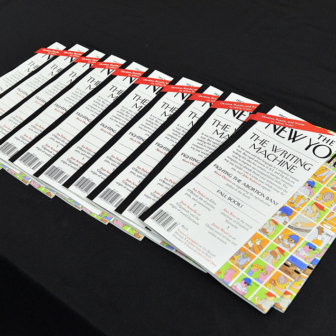If you’re looking for evidence that local newspapers play a vital role in regional Australia, you don’t need to look any further than northern New South Wales. After the local News Corp paper, the Northern Star, suspended its print edition earlier this year, a group of the company’s former journalists launched the Northern Rivers Times, a free weekly newspaper serving a stretch from Tweed Heads to Grafton. The eighty-page first edition reflected the demand from local advertisers as well as readers.
The team behind the paper says that a circulation of about 15,000 will make the Northern Rivers Times a viable business. The early signs are good: when they first announced the new paper, they reported receiving more than 16,000 messages of encouragement, and on the day the first issue appeared nearly 900 emails arrived from businesses, the community and politicians — not only from the northern rivers area but from all over the state. The first three issues have covered a diverse range of topics, including local council news, community events, education, health and sport, and each edition includes a TV guide, classifieds and a community billboard. The paper’s aim is to meet audiences wherever they are and whatever they want, and not just online.
Almost since the first European settlers arrived, regional and community newspapers have been at the heart of Australian life. But last summer’s bushfires and this year’s pandemic have accelerated the collapse of local papers that had already been shrinking in the face of digital disruption.
In April, with sales and advertising down during the first wave of Covid-19, Australian Community Media, which owns 160 regional newspapers including the Canberra Times, the Newcastle Herald, the Border Mail and the Bendigo Advertiser, temporarily suspended its non-daily print editions and shut down four printing sites. News Corp, which has the largest network of local papers, stopped the print editions of more than a hundred community newspapers and converted most of its titles to digital-only.
All told, according to the Public Interest Journalism Initiative, more than 200 news outlets have been suspended or closed since January 2019, 80 per cent of them during the pandemic. This has left a critical gap in local news provision.
But the trend isn’t all one way. News Corp announced last month that it will launch fifteen new digital-only mastheads in major centres of regional Victoria, New South Wales and South Australia this year, with a plan to establish up to fifty digital titles across Australia over the next three years. News Corp also foreshadowed the return of the print versions of three local papers in Sydney — the Wentworth Courier, the Mosman Daily and the North Shore Times.
Meanwhile, community-backed papers have emerged in a range of regional towns where existing print editions had been suspended. The new papers include the Yass Valley Times, the Southern Highlands Express, the News in Naracoorte, South Burnett Today, the West Queensland Echo, Wet Tropic Times, the Ararat Advocate, the Hunter River Times and the Braidwood Changing Times, with more in the pipeline.
This flurry of activity has a clear message: local news is essential for regional communities. These communities want their stories told. But while these new ventures are a cause for optimism, not all towns will benefit. Other measures are needed to preserve and expand the strengths of local news-gathering.
When we surveyed 2038 news consumers in regional areas across Australia in November and December last year, we found that a majority of them (88 per cent) — and especially those with lower socioeconomic backgrounds — access local news sources regularly. One in five reported having been affected by the closure or merger of a news service in their area in the past five years. If we conducted the survey again today, the affected number would likely be much higher.
Not only did one in five respondents say they had lost a local news service, one in four said they had no local TV news service or newspaper. One in three said there was no local commercial radio servicing their community, and more than half (55 per cent) told us ABC local radio doesn’t have a presence in their area.
Instead, almost a quarter were accessing local social media sites to get local news. The use of these sites is growing: almost half of the respondents said they have joined a social media group, such as Facebook Groups or group chats on WhatsApp, to get local news. These hyperlocal sites are now the fourth-most-used source of local news among regional news consumers.
Our study reveals that people who live in areas that have lost a local newspaper or TV news service believe the loss of local information has reduced their sense of belonging. According to these consumers, the remaining news offerings in their area are not meeting their needs.
This lack of satisfaction is serious, because people in regional Australia rely more heavily on local news services than do their counterparts in cities. The Digital News Report: Australia 2020 shows that more than twice as many regional news consumers access local newspapers (24 per cent) compared with city consumers (11 per cent).
It is the desire for community connection that drives the need for local news in regional areas. Respondents told us they access local news to know what is going on in their local area (87 per cent) and to understand how things may affect them (86 per cent).
In a separate study of regional journalists we found that many of the reporters working for local news outlets, particularly independent newspapers, live locally, which gives them a deeper local knowledge and a sense of commitment to the community they are reporting on. This may be one reason why regional audiences have greater trust in local news (63 per cent) than news generally (48 per cent). Regional Australians who regularly consume local news also say they are satisfied with the relevance (84 per cent) and accuracy (81 per cent) of local reporting.
Where gaps exist, regional audiences are keen for new offerings. About a third of those who don’t currently have access to traditional local news media are willing to financially support a new online grassroots news service. People who live in areas that have lost news outlets, and those who get their news from community newsletters, bulletin boards, local social media groups, websites or other local residents are particularly interested in supporting additional local news options. So are younger people and those with higher levels of education and income.
Yet the amount people are willing to pay for an extra local news service is still quite low. Fewer than half (46 per cent) are willing to pay up to $5 per month for a monthly subscription, regardless of whether that is for just one news brand or a bundle of titles.
These modest amounts highlight the dilemma facing the news industry as it struggles to replace lost advertising dollars with payments by readers. While the culture of paying for online news is slowly gaining traction among Australian news consumers, only 14 per cent are currently willing to pay. According to the Digital News Report: Australia 2020 only 8 per cent of Australian news consumers have an ongoing news subscription. The majority may never pay.
The financial struggle facing the Australian news industry is worse in many regional areas, particularly with Covid-19 having affected local businesses and advertising sales. In response, some short-term relief has been offered from a range of sources. For instance, the Australian government created a relief package in April, including a $50 million public interest news-gathering program. The Australian Communications and Media Authority announced that forty-one small and regional publishers will share $5 million in innovation funding. As part of a $2 million investment, seventeen newsrooms across Australia will receive funds from the Facebook Journalism Project Relief Fund. And Google announced emergency funding for local newsrooms.
Longer term, the federal government is pushing ahead with its code of conduct for negotiations between news outlets and the major technology platforms. Administered by the Australian Competition and Consumer Commission, the code will require the major platforms to share advertising revenue with news organisations. Its precise impact on different media outlets is yet to become clear.
Meanwhile, the search for additional revenue continues. News Corp’s digital-only experiment in local publishing will be interesting to watch. Behind a paywall, it will offer hyperlocal news content written by journalists living and working in the community, the kind of news local audiences say they want. But the current business model means local journalists face low pay, long hours and isolation, particularly when they work in single-person newsrooms.
Overseas, various models for local news are being tested, four of which are particularly noteworthy. Berkeleyside is a direct public offering funded by more than 300 readers. Devil Strip is a cooperative model under which members of the local community become shareholders in “a publication owned and operated by the people of Akron for the benefit of the people of Akron.” The Colorado Media Project is a philanthropically funded statewide local news initiative providing funding, training, technology and other opportunities.
The most ambitious is the English-language version of the Correspondent, which has been crowdfunded by more than 50,000 founding members from 130 countries to produce ad-free journalism. Rather than a set rate, subscribers are asked to pay what they can afford. This model is based on the success of Holland’s De Correspondent, which has been providing daily news since 2013.
The common thread is that these experimental outlets engage and interact with their supporters not only as readers but also as contributors of their knowledge to stories and participants in the business itself. The aim is to maintain meaningful and long-term relationships between media outlets and their audiences.
Whether it’s online or offline, local news certainly seems to be in demand both from readers and from advertisers. But there is no one-size-fits-all solution: each local media outlet will need to tap into its unique market with multiple revenue streams, multi-platform delivery, and tailored offerings to stop the decline of local journalism. •




